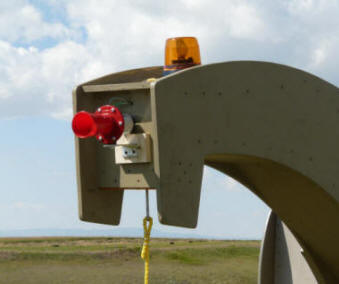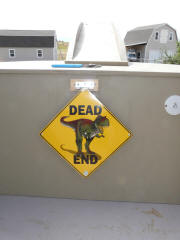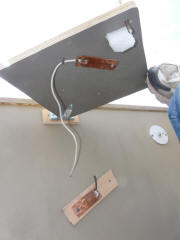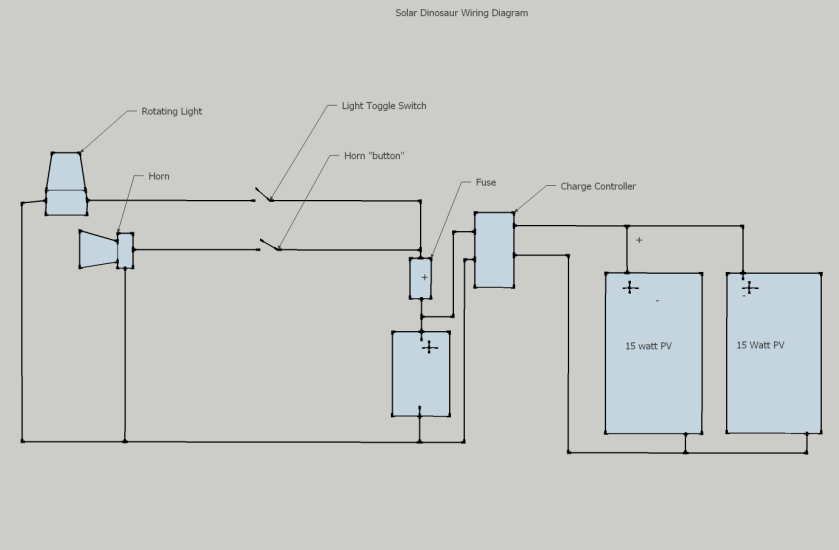
Search
The Renewable Energy site for Do-It-Yourselfers
Building the Solar
part of the Solar Dino
| The small solar electric system powers the dino horn and the
rotating dino beacon light. It has some reserve to power future
solar additions. Any ideas? The system consists of:
Two 15 watt, 16 volt PV panels hooked in parallel
A 12 volt lead acid battery (stolen from the lawn mower)
A small charge controller
12 VDC horn and 12 VDC rotating light
Wire, switches, fuse, horn button.
|
|
The solar panels and charge
controller were from a set I ordered from Costco sometimes back.
The 12 volt battery was stolen from
our lawn mower.
The horn is a an "oogah" horn from
Harbor Freight -- it does sound a lot like I would imagine a dinosaur to sound
-- I guess no one can prove me wrong on this :)
The rotating light is standard
rotating amber beacon made for trucks etc. as a caution light.
I thought that we could mount the PV
panels on the dino, but we could not find a large enough and safe enough place
to put them. So, we moved them a safe distance away and mounted them on
the ground.
The rest of the system is installed
up in the "drivers platform" behind a plywood panel. A wire runs
underground from the drivers platform to the PV panels.
In operation, the horn and light are
run off the battery, and the PV panel charges the battery through the charge
controller. The purpose of the charge controller is to prevent the PV
panels from overcharging the battery.
Two 15 watt PV panels should provide
about (15 watt*2)(4 hours) = 120 watt-hours of energy to the battery on a sunny
day. This is equivalent to (120 watt-hours)/(12 volts ) = 10 amp-hours a
day. So, this would run a 1 amp load for about 10 hours (or a 2 amp load
for about 5 hours, ...). In reality, the charging process and getting the
juice out of the battery process has some losses, so about 80% of these times
might be about right. Anyway, plenty for a horn and light used only a few
minutes a day.
The light is turned on with an
automotive toggle switch bought at an auto parts store.
I puzzled over the horn button for
some time. What I finally came up with is to use the "Dead End" dinosaur
sign that we had lying around. It is mounted with a hinge at the top, so
that it swings in and out. The horn button contacts are two short pieces
of copper pipe that are flattened -- one is mounted to the plywood bulkhead
behind the sign, and the other is mounted to the piece of plywood that the sign
is screwed to. When the sign is pushed toward the bulkhead, the two pieces
of copper come together and close the circuit to the horn. A small piece
of spony packing foam between the bulkhead and the sign keep the contacts apart
until you push the sign and compress the foam. A large head bolt through a
loose fitting hole in the bottom of the sign and into the bulkhead keeps the
sign from being pulled out more than a half inch or so, and protects small hands
from getting close to the contacts.
|

Pressing on the Dead End
sign sound the dino horn. |

The horn contacts are flattened
copper pipe sections soldered
to wires. The small piece of white
foam is the spring that keeps
the contacts normally separated. |
A fuse is used in the battery to horn
and light circuit to protect against short circuits. Even fairly small
lead acid batteries can provide quite a bit of energy on short circuits, so some
protection is important.
The PV panels come mounted on a very
flimsy PVC pipe frame. I decided to support these on treated wood 4X4's.
The vertical post with cross 2X4 supports the top end and lives in a concrete
footing. The bottom end of the panel screws to a 4X4 treated wood piece
that is staked into to the ground with angles 2 ft copper pipe. We get
some high winds, but these panels are not going anywhere.
Wiring Diagram
Here is a rough wiring diagram for
the solar electric system.

I need to clean up the wiring a bit,
but is was functional for the first visit.
Gary September 5, 2009


